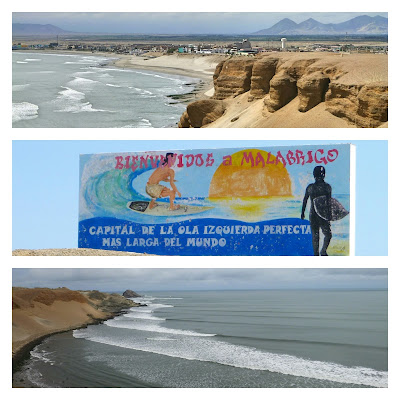We had an easy border crossing from Ecuador into Peru. However, we experienced our first taste of Peruvian corruption on that first day in Peru. The border guards seized a box of our ready-meal quinoa for their lunch! (Torrey was actually pretty happy about this as he doesn't like the ready-meal quinoa).
Peru has a huge coastline, which means lots of olas y mariscos (waves and seafood). Puerto Chicama is world famous for its veeeeeery long left hand break. If the swell is pumping from the right direction, you can ride a wave for over 2km down the coast! It wasn't breaking that well when we were there, but it was still a long and fun wave.
Peru has a huge coastline, which means lots of olas y mariscos (waves and seafood). Puerto Chicama is world famous for its veeeeeery long left hand break. If the swell is pumping from the right direction, you can ride a wave for over 2km down the coast! It wasn't breaking that well when we were there, but it was still a long and fun wave.
Puerto Chicama- capital of the longest, perfect left wave in the world
The nearby town of Chiclayo is the home of some of the best ceviche we have had. We have had a lot of ceviche on the trip, but this was by far the best.
We also checked out the surf town of Huanchaco. The waves were big and fat. Freecamping is possible on the beach here, but not worth the aggravation of security guards knocking on your window and asking for propinas (tips)- if we wanted to pay we would have gone to a hostal amigos!
We visited two ruins in the area, Tucume and Chan Chan. These were both enormous civilisations, older even than the Incas. The cities were made of adobe (mud) so they haven't aged as well as other pre-Columbian cities we have been to. It's still possible to get your head around the scale of the cities, and learn something of the fascinating history of these people.
Ceviche served on boiled yucca, with corn and cancha (a kind of toasted corn). Yummmmm
We also checked out the surf town of Huanchaco. The waves were big and fat. Freecamping is possible on the beach here, but not worth the aggravation of security guards knocking on your window and asking for propinas (tips)- if we wanted to pay we would have gone to a hostal amigos!
We visited two ruins in the area, Tucume and Chan Chan. These were both enormous civilisations, older even than the Incas. The cities were made of adobe (mud) so they haven't aged as well as other pre-Columbian cities we have been to. It's still possible to get your head around the scale of the cities, and learn something of the fascinating history of these people.
Capital of the Chimu culture, Chan Chan was the largest pre-Columbian city in South America
Tucume covers an area of 540 acres and contains at least 26 important pyramids. The founders of the city believed that the outlying hills held important powers, and by building pyramids that replicated those hills, they could harness that power




No comments:
Post a Comment